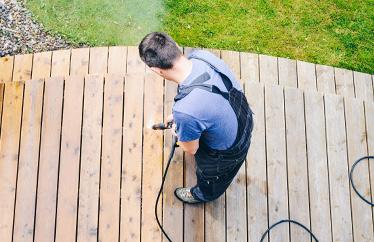How to Prepare Your Home for Power Outages

There’s never a good time for a power outage. Whether you're cooking dinner, putting your kids to bed or trying to catch up on some TV, having everything suddenly go dark is a shock. Not only do you have to go hunting for flashlights, but your devices and food are suddenly much more vulnerable to damage from power surges and mold.
As annoying as power outages can be, as a homeowner, you need to be prepared for them. From how to prep your home for extended periods without power to keeping everyone entertained and safe throughout the entire ordeal, we’ve got you covered with our guide on how to prepare for a power outage.
Table of contents:
- Creating a go-bag
- Family medical checklist
- How to stay comfortable in your home
- What causes power outages?
- Power outage map
- Post-power outage recovery
- More resources
1. Keep non-perishables on hand
Unlike extreme weather events that you can see coming, power outages can happen without warning. Because of this, it's a good idea to stock up on non-perishable foods ahead of time so that your family can ride out whatever comes your way. Nutritious non-perishable foods to keep on hand include peanut butter, canned meats, trail mix, granola bars, canned vegetables, sports drinks and dried fruit.
As a rule of thumb, it’s a good idea to stock up on at least three days of food and water per person (and pet) in the event of an emergency. The CDC recommends storing 1 gallon per person per day. However, if you live in a hot climate or have pregnant or elderly members of your family, you should keep even more supplies on hand to ensure everyone is adequately hydrated and fed.
2. Create a go-bag
Part of your emergency preparedness plan should be creating a go-bag. Go-bags allow you to evacuate your home quickly and safely without leaving behind what’s most vital. What goes inside your go-bag depends on the disasters you’re prepping for, as well as your family’s unique needs.
In general, sticking to the go-bag list below should help you grab the essentials. But it’s also necessary to take into consideration any medical needs your family has. Consider how long you’ll be gone if you do have to evacuate and what you absolutely can’t lose in the event your home gets damaged or becomes a total loss. By adding in those items, in addition to our comprehensive list, you’ll be able to sleep soundly knowing that you’re ready if disaster strikes.
- Important documents such as birth certificates, wills, medical records, Social Security cards, passports, driver’s licenses, a list of emergency contacts, etc.
- Medicine
- Flashlights
- Batteries (multiple sizes)
- Snacks and water
- First aid kit
- Comfort items (especially relevant for children during stressful times)
- Phone charger and external charger
- Extra clothes
- Water bottles
- Pet supplies, food and leash
- Matches
- Walkie talkies
Set a reminder in your phone to update these items each year so that you aren’t carrying around a bag of expired products the next time you head out with your go-bag.
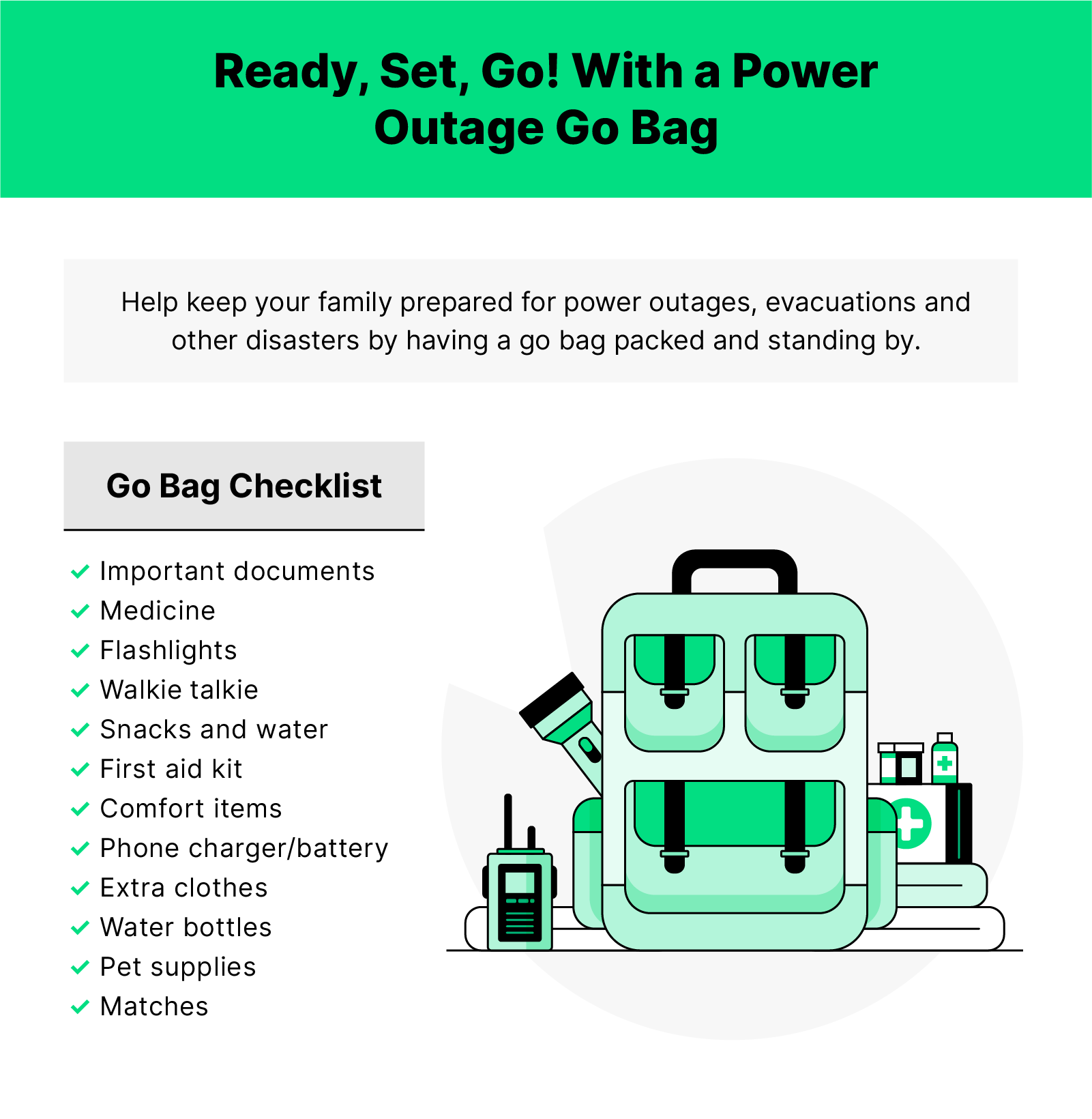
3. Stay informed
When the power goes out, so does your access to traditional media like TV. Luckily, you can stay up to date with the latest weather alerts in your area through your smartphone. Either by social media or specific weather apps, you can choose to receive push notifications for what you need to know (just don’t forget to pack a phone charger and an extra battery in your go-bag).
In addition to local apps from your favorite news stations and your utility company, consider adding the following to your phone’s library so that you can stay connected and informed no matter what.
- The Weather Channel
- Weather Underground
- Natural Disaster Monitor
- American Red Cross First Aid For Human and Pets
- Zello
4. Add surge protection throughout your home
During a power outage, many devices become unusable. But they should still work when the power comes back on, right? Unfortunately, that’s not always the case. Some power outages cause surges that can damage your appliances or devices, leaving you with a malfunctioning or utterly fried piece of tech.
Save your hard-earned money (and your data) with surge protectors. Use one anywhere you plug in devices such as computers, TVs and gaming systems to ensure that when the power flickers out, it doesn’t take your technology with it.
5. Fill your gas tank
Though power outages don’t require evacuations as often as other disasters like hurricanes, it never hurts to be prepared. To ensure your family can get where they need to go, fill up your gas tank regularly and never let it get less than half full. This way, if a summer heatwave causes an overloaded power grid, you don’t have to worry about running out of gas driving to Grandma's for some much-needed AC.
6. Plan for medical needs
Over time, your family’s medical needs may change. That means the meds you added to your go-bag five years ago may no longer be necessary by the time you actually need to “go.” To keep your supplies up to date, have a medical checklist on hand for every member of your family.
These checklists should include prescription information, emergency numbers, known allergies, dosing and storage instructions and anything else that’s crucial to maintaining your family’s health during an emergency. Download the checklists below (and update them yearly) to keep things on track.
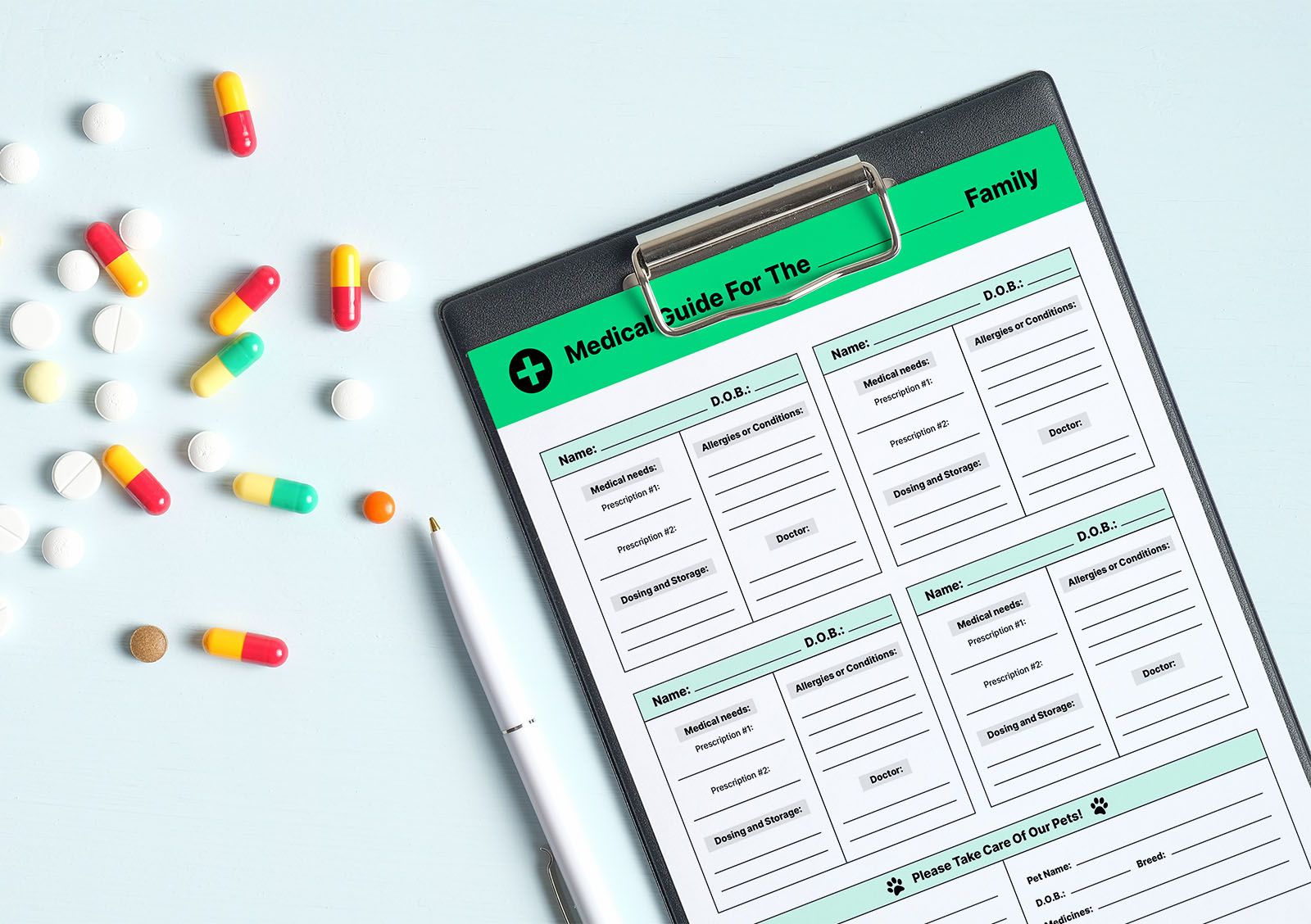
7. Check on your smoke and carbon monoxide detectors
Here’s one task you can check off your list right now: set up a recurring reminder on your phone to replace the batteries in all smoke and carbon monoxide detectors every six months. Even though these devices run off electricity in many homes, they often rely on batteries for backup power. By setting up recurring reminders, these devices will never run out of juice no matter how many times the power goes out.
8. Buy a generator
If you live in an area where power outages are common, like Chicago in the summer time, you might want to consider investing in a generator to power your home (or just the necessities) while you wait for the power to be restored. While what kind of generator you’ll need depends on what you want to keep running, there are a few crucial things to recognize about staying safe when using a generator:
- Never use a generator indoors
- Keep the generator dry at all times
- Use the generator at least 20 feet away from your home
- Even at 20 feet away, it’s recommended to keep all doors and windows closed to avoid carbon monoxide from entering your home
- Only refuel when the generator is off and cooled down
- Unplug all appliances and electronics before turning on the generator
- Only use generators through professionally installed power transfer switches
9. Prepare alternative light sources
Power outages during the day are a nuisance, but at night they’re another issue entirely. Make sure that you can see while cooking, doing a puzzle or just walking to the bathroom by stocking up on alternative light sources well before the power goes out. Flashlights, glowsticks, lanterns, reading lights and candles are all good options to keep things illuminated and cozy during the next outage.
Keep in mind that if you end up lighting candles, practicing fire safety is key. This means never leaving open flames unattended and double checking that you have plenty of fire insurance.
10. Stock up on entertainment
Power outages can be boring. After all, how are you supposed to pass the time when you can’t turn on your TV let alone see 5 feet in front of you? Staying entertained is a must in prolonged outages, especially if you have kids. Make sure you have plenty of board games, coloring books, glowsticks, puppets, lanterns and backup external batteries for your phone to keep things fun, even in the dark.
11. Get what you need to stay comfortable
No matter where you live, if the power goes out, you become susceptible to the elements. If an outage happens during extreme weather, staying comfortable is easier said than done. As soon as the power goes out, your home will start to heat up immediately (or cool down, depending on the temperature outside). Though it may stay comfortable for the next 8 to 12 hours, if you’re dealing with a long-term outage, you’ll quickly discover that it isn’t nearly long enough.
Try out the following tips to keep your family safe during long-term outages:
- Winter power outage safety tips
- Set up a tent on top of your mattress to keep warm
- Stay in one room during the outage and close doors to unused rooms
- Wear multiple layers of loose clothing
- Avoid alcohol and caffeine
- Cover windows and doors with blinds, blankets or towels
- Summer power outage safety tips
- Keep the fridge and freezer doors closed as much as possible
- Take a cold bath to keep your body temperature low
- Keep external doors and windows closed at all times
- Stay in the lowest level of your home and wear loose, lightweight clothing
- Block the sun with blinds, blankets or towels
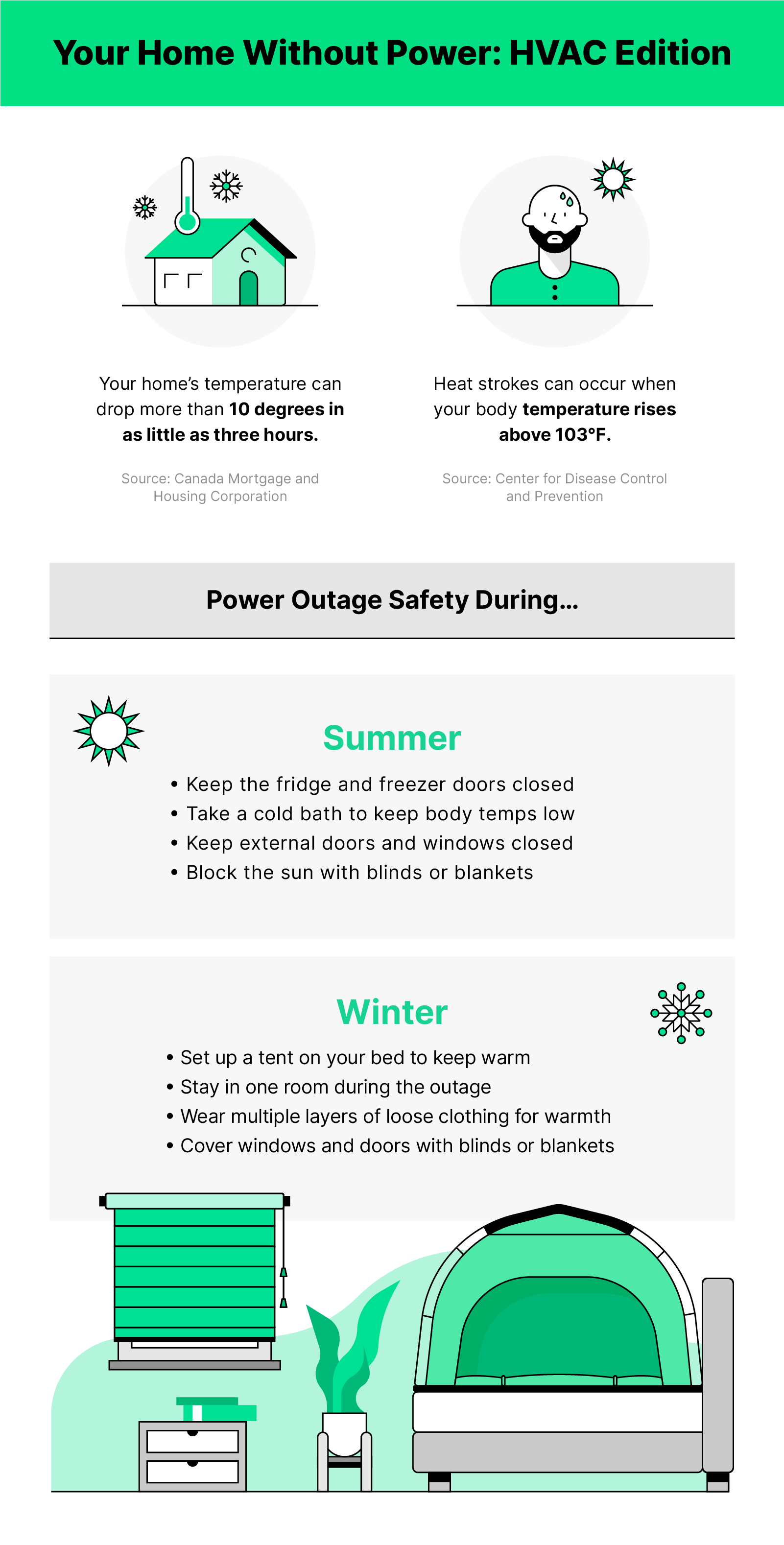
12. Track your appliance temperature
The age-old trick of freezing a cup of water and putting a quarter on top is no longer the only way to ensure your food is safe to eat. Appliances are smarter these days — thanks to an influx of kitchen technology — and they can let you know when temperatures have gone above safe levels so that no one gets food poisoning. If you have an older fridge or freezer, there are plenty of devices you can purchase and place inside to track the temperature and send you updates in real-time.
What causes power outages?
Power outages can happen for various reasons, including extreme wind, storms, earthquakes, hurricanes, lightning, animal damage, fallen trees and overloaded grids. While damage from severe weather is a well-known cause, there’s been an increase in overloaded grids causing outages in recent years. Places like Texas have experienced state-wide outages during severe winter storms, while northwestern states like Washington and Oregon are experiencing the same due to unprecedented heatwaves.
Other things to consider include what kind of area you live in and how close you are to essential services like fire departments, hospitals or water treatment facilities. Rural areas are more likely to experience power outages than suburban or urban areas. And if you’re on the same power grid as emergency services, you’ll be less likely to lose power as city governments prioritize keeping the lights on in those areas.
While you can’t do much to prevent an outage from happening in the first place, you can prepare your home to withstand it. In addition to packing your freezer and using surge protectors, the best way to keep your home prepared is through a modern home insurance policy. With a provider like Hippo by your side, you’ll have more coverage on your tech and appliances than you would with other providers, meaning you’ll be financially protected no matter what comes your way.
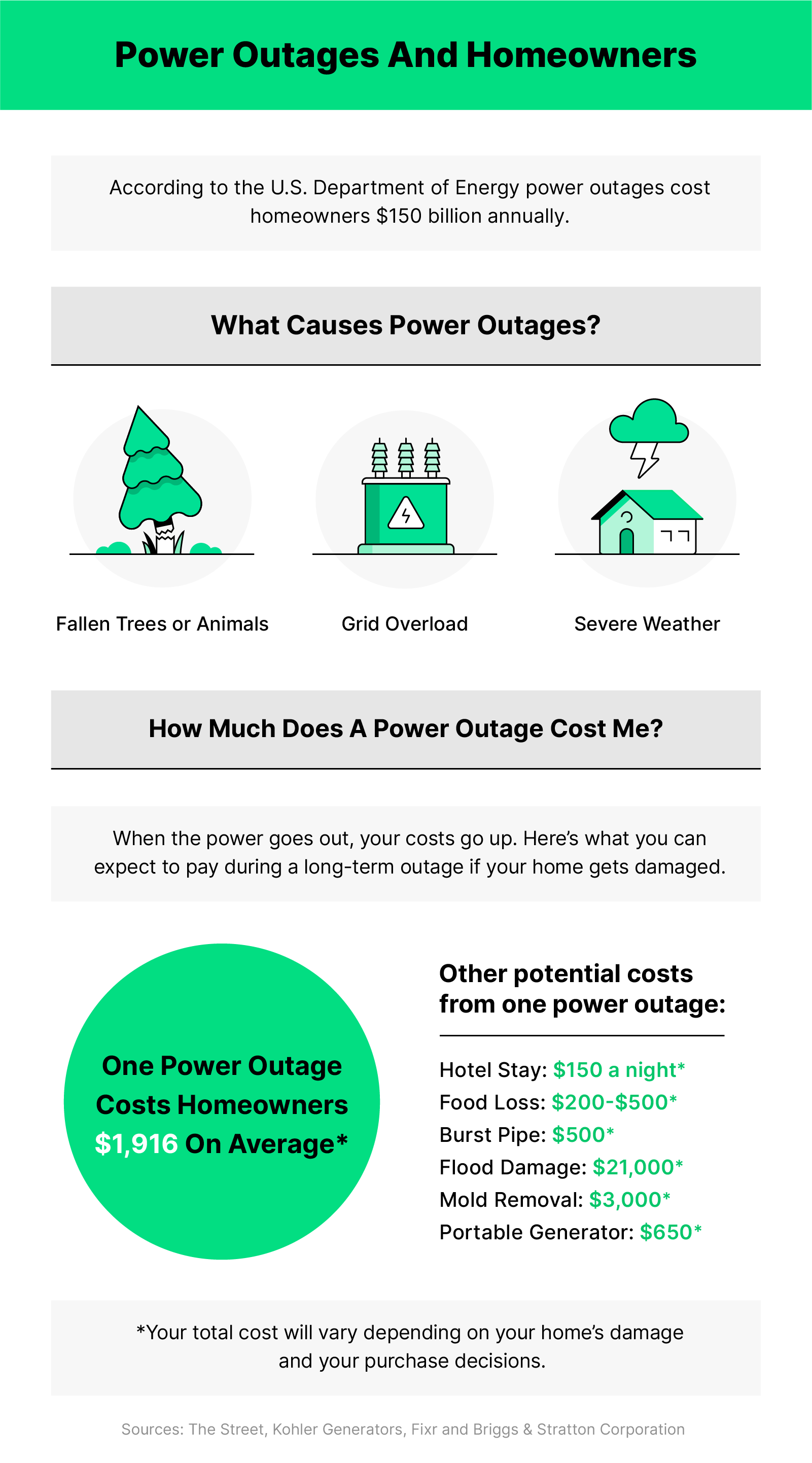
Short- vs. long-term power outages
Most of the time, when your power flickers out, you don’t have to wait that long for it to come back on. But if the damage to the power grid is severe enough, you may be in the dark for hours — or even days. Keep an eye on your local utility company's website for updates on when power is estimated to be restored.
If your utility company is estimating a short outage, you don’t need to do too much. You can dip into your emergency rations for food and play games to pass the time. But if they’re unable to give an estimate, you’ll need to begin rationing. Start by taking inventory of how many non-perishables you have, and figure out how long you’ll be able to sustain yourself at home before needing to venture out. If the weather is severe, make sure to follow our above tips for summer and winter outages to keep your family comfortable for the next few days. Report sustained outages to your utility company and, if necessary, seek an alternative shelter.
Also, please note that some states are more prone to outages than others, such as Maine, West Virginia and Louisiana. See how susceptible you are to power outages with the map below.
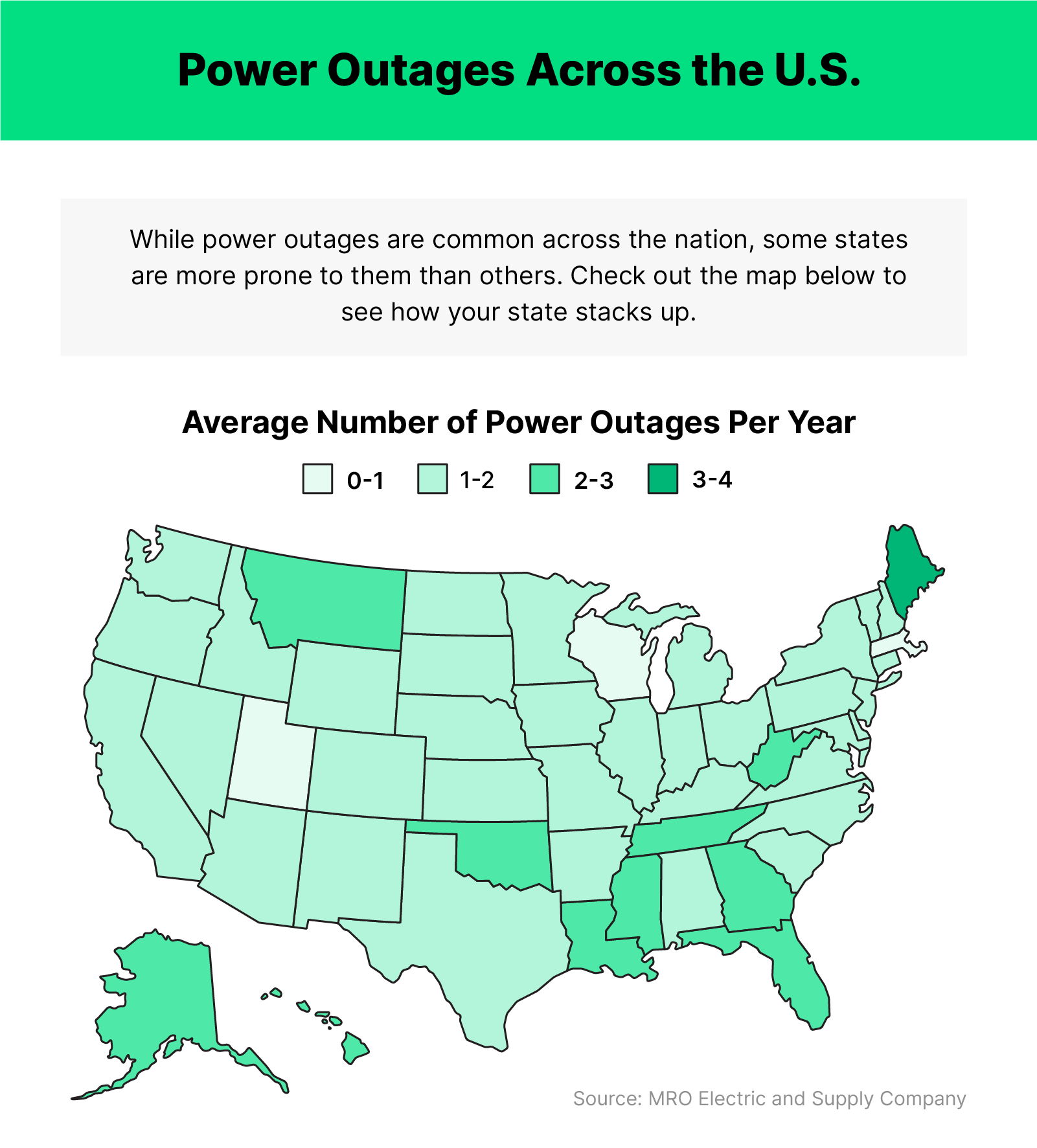
What should you not do during a power outage?
We’ve talked a lot about what to do during a power outage, but there are also a few things you definitely should not do. From how to conserve electricity, water and battery power to what not to do to stay warm, make sure to let your family know about the following rules:
- Don’t open the fridge and freezer more than necessary
- If you see pooling water outside or inside the home, do not go near it
- Don’t turn on the stove or oven for warmth
- Do not take long, hot showers
- Use your phone’s flashlight only when needed
- Don’t keep everything plugged in and the light switches on
- Don’t grill or bring a generator indoors
- Don’t forget to wrap your pipes in the winter
Post-power outage recovery
When the power does come back on, it’s tempting to breathe a sigh of relief and kick your feet up. However, there’s still work to be done. The first step is to go around the house and extinguish any candles, lanterns or fireplaces to avoid accidental fires. Next, you’ll need to check on your food to see if anything is spoiled. According to the CDC, you should throw out perishable items such as meat, dairy, eggs and cut fruits or veggies if you’ve been without power for more than four hours. Frozen items should be safe for 24 to 48 hours without power, depending on how full your freezer is.
If another outage occurs, it’s a good idea to charge up your phones and other devices while you can. Just make sure to use a power strip when charging so that if a power surge occurs, your devices are safe.
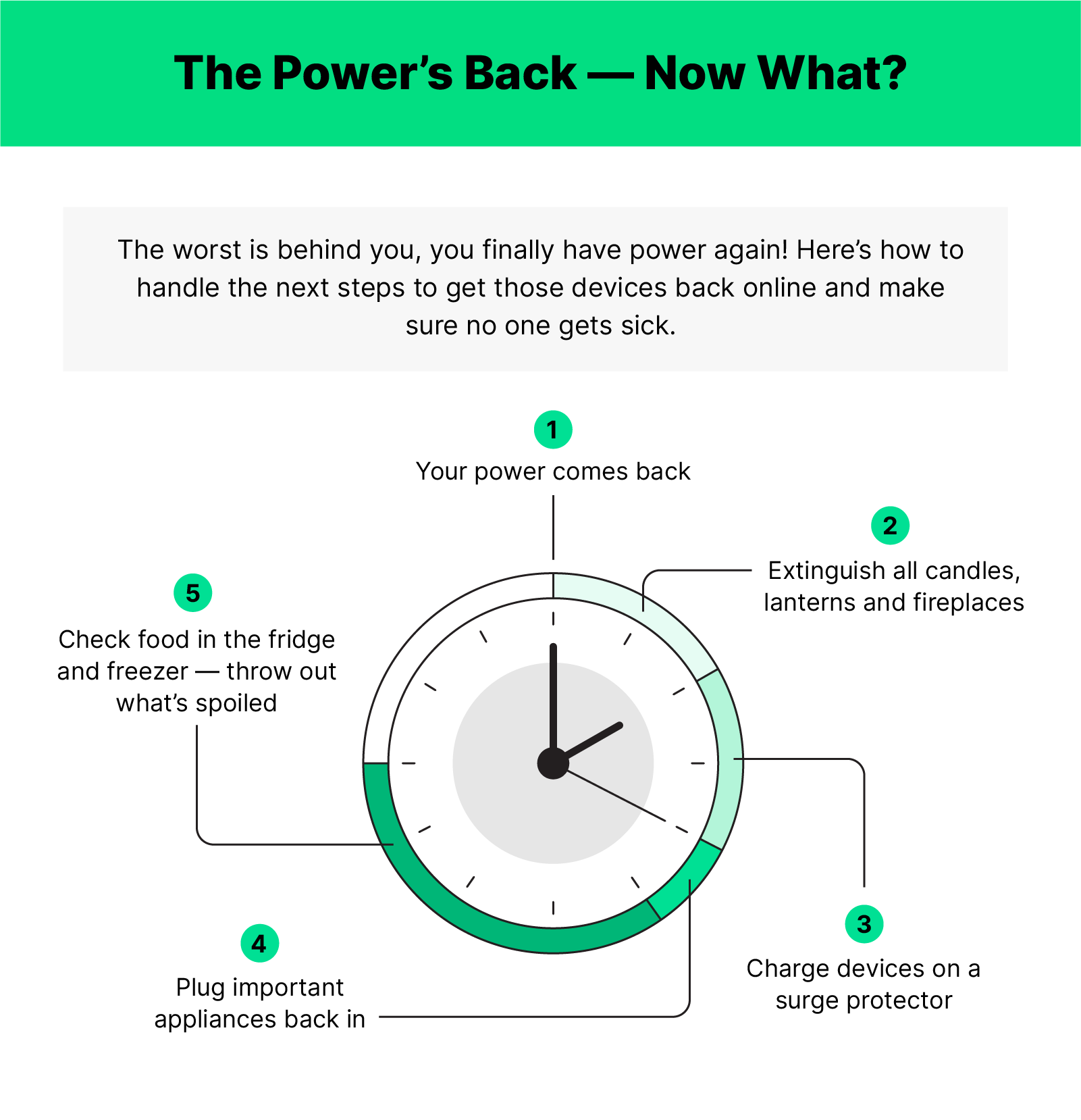
More power outage resources
Looking for more information on power outages? Below, we’ve rounded up expert resources to ensure you can prep, protect and recover with ease.
- Power Outage Safety by The Red Cross
- Resources for Parents by Cleo
- What You Need to Know When the Power Goes Out Unexpectedly by The CDC
- Power Outages by Ready.gov
- How to Make a Disaster Plan for Your Pets by The Humane Society
- Emergency Preparedness for Pregnant Women by American Public Health Association
- Power Outage Map by PowerOutage.us
- Caring for your Baby or Toddler During a Power Cut by Baby Center
- Emergency Preparedness for the Elderly by Choose Energy
It can be hard to see the light at the end of the tunnel during a power outage — both literally and metaphorically. Stay ahead of the storm by working with a modern home insurance provider like us, who can walk you through how to protect your smart home devices just as quickly as we walk you through the claims process.



